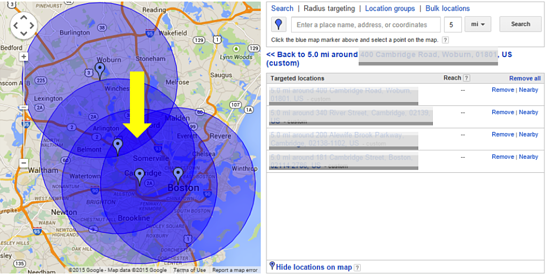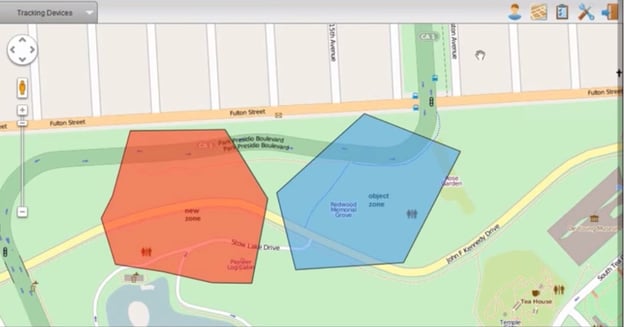Geo-fencing is one way to accomplish what’s known as location-based marketing. Geo-fencing can be attractive to marketers because there’s an inferred relationship between location and intent.
Intent is a hot term in digital marketing today. Marketers are using a variety of means to infer the purchase intent of someone using a digital device. Perusing certain types of content, whether identified by a keyword phrase associated with that content (how to buy a used car) or the content itself, such as car shopping sites or apps is one potential signal of a visitor's intent, in this case, to buy a used car.
Search marketing, whether it be organic search or paid search marketing is often taken as valuable because someone has an intention when they’re placing a term in a search box.
Location can also be a proxy for someone’s intent. Someone visiting a shoe store may be in the market for shoes, someone else in line at a QSR (Quick Serve Restaurant) probably has an intent to purchase a brand of food and may be open to an offer that increases their order size.
In addition to retail and restaurant businesses, the types of businesses that use location-based marketing include auto dealerships, banks, doctors offices and real estate offices.
There are several types of location-based marketing including geo-targeting and geo-fencing. Both types of advertising targeting are for reaching mobile devices that are communicating their location.
What is Geo-Fencing?
Geo-fencing is using a location-based service in which a device, software or app uses one or more reference points to establish its location and to trigger an action. Reference points include GPS, Bluetooth, Wi-Fi or Cellular tower signals which can enable a mobile device to be located accurately to within a few feet of its actual geographic location.The action triggered that’s important to marketers is usually the serving of ads, although it could be the sending of a text or email message also. The trigger happens when the device is within the boundaries of a geometric shape that’s defined with the goals of the triggering event in mind.
What’s the Difference Between Geo-Targeting and Geo-Fencing?
Generally, geo-targeting is considered as advertising close to a location and is sometimes called ‘pin and radius’ marketing. In an advertising tool, you ‘drop a pin’ by identifying a precise location, such as a street address or a lat / long location and then you define a radius around that pin location that you want to reach devices in.

Example of Geo-Targeting - Courtesy HubSpot
Geo-fencing on the other hand is far more precise. With Geo-fencing you draw a geometric ‘fence’ around a location. This could be a store, an auto dealership parking lot or a business building.

Example of Geo-Fencing - Courtesy Wikipedia
How is Geo-Fencing Affected by the Upcoming Changes to Apple iOS (iOS 14)?
There are significant changes coming to the Apple operating system. The ones that are in the news are related to new privacy settings for Apps. Consumers will now be proactively prompted on the installation of new Apps to select privacy settings. Among these settings is the location information shared with apps.
Some apps, such as navigation apps, require a precise device location in order to work effectively. Other apps, such as weather apps, may need only an approximate location in order to work ok, and many other types of apps, such as most games, are location agnostic. Apple will allow users to control the location shared with a specific app, including an ‘approximate location’ option that shields the precise location of the mobile device from the app developer but provides a ‘close enough’ approximation for apps like weather.
The App ecosystem historically evolved in such a way as to harvest as much monetizable device data as possible, and those days are over. As consumers opt out of most of these data-harvesting functionalities, it will become more difficult to do in-app functionalities, such as location-based advertising as was previously done.
This creates an opportunity for programmatically-driven location based advertising, including geo-fencing, as these ads are served outside of apps. Even this comes with a proviso, however.
One form of geo-fencing has been ‘device harvesting’ whereby device IDs (MAIDS or IDFAs) can be gathered up based upon time and location within a geo-fenced area. The device can then be added to an advertising pool for advertising for some length of time.
While the ability to advertise on a device within a geo-fence appears to be still possible with these upcoming iOS changes, ‘following’ devices for a period of time once they leave a geo-fenced area appears to be about to be limited. The market may adapt and ‘approximate location’ data will likely find a market for certain types of advertising.
Programmatic tools utilize a range of sources for location data, so while a single app may no longer be able to provide location-based advertising, programmatic advertising tools will likely be able to cobble together enough location signals to continue advertising strategies such as geo-fencing.
This is important because geo-fencing can be extraordinarily effective for marketers. Dunkin Donuts showcased it with a coupon offer geo-fencing execution that drove significant results and one study showed the geo-location advertising doubled the effectiveness of mobile ads.



